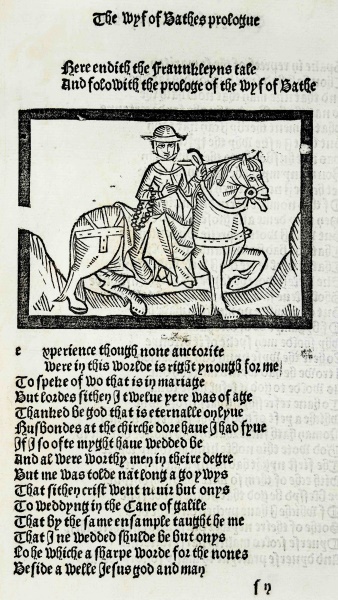Chaucer: Canterbury Tales
The canonized author of early English literature, the writer whom the fifteenth-century poets dubbed "the father of English literature," arose from the merchant class. Geoffrey Chaucer’s father, a vintner, placed the younger Chaucer with the monarchy so that he could perform as a page in the household of the Countess of Ulster, Prince Lionel’s wife. Chaucer would later move to labor outside monarchical households as a forester, a sheriff, a keeper of the gates in London, and possibly even a spy in Spain. All of these professional encounters provided vast storehouses of information for Chaucer’s imagination.
In an irony that Chaucer himself would likely enjoy, the work for which he is best known today is a collection of stories, so named The Canterbury Tales, that Chaucer never completed before his death. How did it come to pass that Chaucer’s incomplete text has come to be the one for which he is known? Three intersecting events—not seemingly connected—contributed to Chaucer’s not only being remembered as a writer but also as the writer of The Canterbury Tales.
One of those "events" is a "retraction" that Chaucer delivered before his death, perhaps on his death bed. This Retraction, as it has come to be known, was first recorded, then preserved, and is now appended to the end of The Canterbury Tales, following "The Parson’s Tale." The Retraction, which Chaucer dubs his "litel tretys," does more than confess Chaucer’s sins:
Now preye I to hem alle that herkne this litel tretys or rede [read], that if ther be any thyng in it that liketh hem [them], that thereof they thanken oure Lord Jhesu Crist. … And if ther be any thyng that displese hem, I preye hem also that they arrette [attribute] it to the defaute of myn unkonnynge [unenlightened state]. (X 1081-82)
The validity of Chaucer’s Retraction as a confession is troubled by at least three contingent realities. One of those realities dominates the other two: Chaucer died a pauper. That reality unfolds as follows: Henry IV seized the throne from his cousin, Richard II. Because of this throne seizure, Chaucer’s annuity payment was in arrears. If Chaucer wanted his body buried properly— and this conclusion is as reasonable for Chaucer in the Middle Ages as it is for us now in modern times—he needed to retract the composition of "many a song and many a leccherous lay [lecherous poem]" (X 1086) that could sometimes be considered rather racy, like, by way of two examples, "The Miller’s Tale" or "The Merchant’s Tale."
A second contingent reality brings us to consider the desire all writers express: being remembered. What better way to preserve one’s works for posterity than to have a scribe record them all? In this Retraction, Chaucer lists all the texts he remembers composing. Three he decides not to disown, but of the ten works he mentions, one has never been found: "the Book of the Leoun" (X 1985).
The third of these contingent realities is that Chaucer’s eldest son, Thomas, soon after his father’s death, arranged in 1400 to have The Canterbury Tales cast into a beautiful volume, written by a trained scribe. This volume, now known as "The Ellesmere Chaucer," includes elaborately introduced paragraphs and—what perhaps has caused the most delight—miniatures of all the pilgrims who tell tales. Among these miniatures is Chaucer himself, who as a pilgrim tells two tales: "The Tale of Sir Thopas," which is interrupted midway and denounced as "drasty rymyng [crappy rhyming]" (VII 930), and "The Tale of Melibee," which is "a moral tale virtuous" (VII 940).
At the same time that his father was retracting at least seven of his works, Thomas was having one of his father’s retracted works cast into a beautiful volume that remains to this day and is currently housed—and on display—in the Huntington Library in San Marino, California. "The Ellesmere Chaucer" is one of two oldest versions of Chaucer’s Canterbury Tales that has survived. The Stuart Rose copy on exhibit at the Roesch Library is one of the modern print editions.
—Miriamne Ara Krummel, PhD, Associate Professor, English
Bobbi Sutherland, assistant professor of English, reflects on her first experiences reading the Canterbury Tales and discusses the significance of Geoffrey Chaucer’s work for medieval historians. Interview is an online supplement to the University of Dayton exhibit Imprints and Impressions: Milestones in Human Progress—Highlights from the Rose Rare Book Collection, held Sept. 29 through Nov. 9, 2014.
Chaucer, Geoffrey. The Riverside Chaucer, 3rd ed. Larry D. Benson, gen. ed. Houghton Mifflin Company, 1987.
Hanna III, Ralph. Pursuing History: Middle English Manuscripts and Their Texts. Stanford University Press, 1996.
Howard, Donald R. Chaucer: His Life, His Works. His World. Fawcett Columbine, 1987.
Lerer, Seth. Chaucer and His Readers: Imagining the Author in Late-Medieval England. Princeton University Press, 1993.

